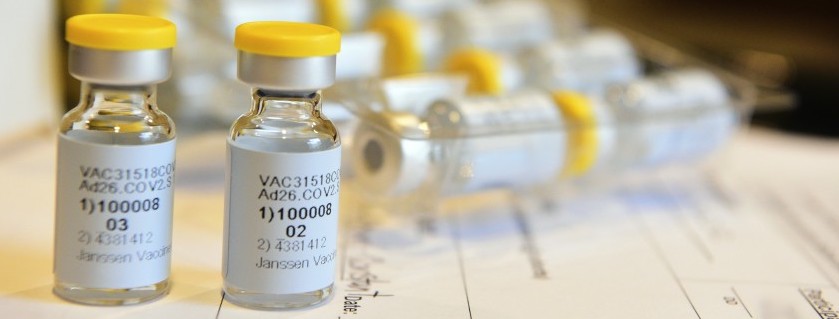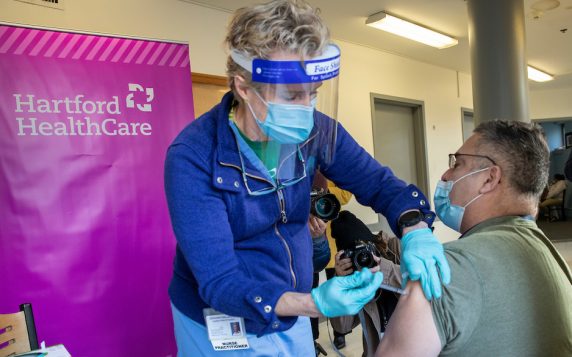The Food and Drug Administration could authorize a third COVID-19 vaccine as soon as this weekend after releasing an analysis Wednesday showing Johnson & Johnson’s one-dose vaccine offers substantial protection against severe illness and death from the virus.
Up to 4 million doses could be shipped to states, pharmacies and community health centers as soon as next week, according to a White House official.
Here’s a quick look at the vaccine:
Efficacy
The FDA called the vaccine safe and effective after reviewing data from clinical trials. In those clinical trials, Johnson & Johnson’s vaccine had a 72 percent overall efficacy rate in the United States. That means clinical trial participants who received the vaccine had a 72 percent lower risk of getting COVID than people in the control group who were not vaccinated. (To learn more about the difference between vaccine efficacy and how it differs from vaccine effectiveness, click here.)
In South Africa, where health officials identified a highly contagious coronavirus variant last fall that has since reached the United States, the vaccine had a 64 percent efficacy — seven points higher than earlier data provided by Johnson & Johnson. With an 86 percent efficacy against severe types of COVD-19 in the United States and 82 percent against severe illness in South Africa, the vaccine greatly reduces the risk of hospitalization or death from the virus.
After two doses, the Pfizer-BioNTech vaccine showed 95 percent efficacy and the Moderna vaccine 94.1 percent. But don’t get too caught up in the numbers. The Pfizer-BioNTech trials started counting cases seven days after the second dose. Moderna, in its clinical trials, starting counting cases 14 days after the second dose.
Johnson & Johnson’s clinical trials, meanwhile, were designed to determine if one dose of its vaccine protected against moderate to severe COVID-related illness from 14 or 28 days after the single shot. Next: A study of the effects of a second dose of the vaccine eight weeks after the first.
Remember, the seasonal flu vaccine, depending on the year’s flu strain, is typically no more than 60 percent effective and sometimes as low as 40 percent.
So don’t get picky about which COVID-19 vaccine you’re getting.
“The best vaccine is the one available in front of you,” says Keith Grant, Senior System Director for Infection Prevention at Hartford HealthCare.
Dosage
Johnson & Johnson’s vaccine, unlike the two-dose vaccines from Pfizer-BioNTech and Moderna, requires only one shot. (Shown above, vials of the vaccine being developed by Janssen Vaccines & Prevention, a Janssen Pharmaceutical Company of Johnson & Johnson.)
Side Effects
Common side effects reported during clinical trials were similar to those associated with the Pfizer-BioNTech and Moderna vaccines:
- Arm pain at the injection site.
- Headache.
- Fatigue.
- Body aches.
How it Works
Johnson & Johnson’s AdVac technology is an adenovirus-vectored vaccine like the AstraZeneca-Oxford University option currently approved for use in Great Britain. It uses a an adenovirus, a genetically modified common-cold virus that cannot replicate. But it carries a virus gene into our body’s cells, which then create a coronavirus spike protein — not the actual virus — that prepares the immune system to repel any future infection.
This technology was previously used to develop vaccines for Ebola (approved), Zika, respiratory syncytial virus and HIV (investigational).
Adenovector vaccines use double-stranded DNA to encourage an immune response. Both the Pfizer-BioNTech and Moderna vaccines use mRNA, or single-stranded messenger RNA, technology. These vaccines, the first to use mRNA technology, direct our body’s cells to create a non-infectious form of the spike protein associated with the virus. When the immune system identifies these harmless versions of the spike protein, it creates antibodies to reject the virus. Once vaccinated, if you’re exposed to the actual COVID-19 virus your body’s immune system is prepared to fight.
Storage
The adenovector technology makes the vaccine temperature stable, making it safe to store safely for three months at 35 to 46 degrees, comparable to the temperature inside a household refrigerator. At minus-4 degrees, says Johnson & Johnson, it can remain stable for two years.
The Pfizer-BioNTech vaccine is shipped and stored at minus-94 degrees, requiring special freezers. Moderna’s is shipped at minus-4 degrees. Once thawed, the Pfizer-BioNTech vaccine must be used within five days. Moderna’s remains stable at refrigerator temperatures for 30 days.



